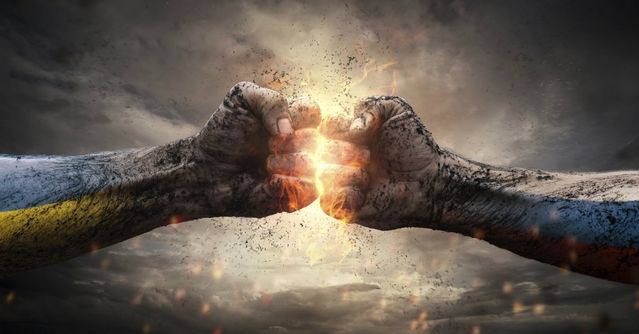Relationships
The Paradox of Conflict
An excerpt from Peace Profile: Dominic Barter and the Paradox of Conflict.
Posted November 29, 2017

Dateline: 2009. The man I take to be Dominic Barter walks to the front of the large room. He is thin, with dark hair that somehow manages to look both uncombed and tidy. Despite the clearly-evident stubble and graying hair, he looks remarkably youthful, but as he begins to speak, it becomes immediately clear that his is an old soul. He is captivating, enthralling, practically mesmerizing. A modern-day Pied Piper, I think to myself.
I don’t mean this pejoratively. He’s not selling anything money can buy. He’s “sharing” an idea, a vision for an alternative system of “doing justice” that resonates with the kind of community many of us dream of living in. More than that, he’s sharing something tangible, real systems that he has built from the ground up in different parts of Brazil. This isn’t Neverland. We can visit these places. We can see these justice systems with our own eyes. We can replicate them in our own communities.
The pull is irresistible. This is a person others want to follow. Some literally do, leaving their jobs and homes to travel with him, to Brazil, to Toronto, and most recently to San Francisco, looking for ways to contribute to his work, but mostly, I think, to just be in his company. There are, after all, ways to contribute without taking on a nomadic existence. I don’t blame them. There are times I too find myself contemplating an extended visit to Brazil. I have no doubt it would be time and money well spent.
*****
Dominic’s big idea is that conflict – any conflict – is neither undesirable nor dangerous, that the danger lies not in conflict itself but in ignoring or attempting to repress it. Thus, Dominic argues, it makes sense to approach conflict through dialogue, rather than through punishment or judgment. The idea is not his, as he would be the first to acknowledge. To the contrary, restorative justice has been practiced in many places across the world, not only recently but far, far back in history. And yet, Dominic’s approach is uniquely his. For more than 20 years, he’s been imagining, developing, and adapting the Restorative Circle (RC) process by experimenting with every possible detail. The result is not so much a conclusion about what works and what doesn’t as a sense of what is essential and what is flexible.
What so far appears essential are 1) a theory of conflict which sees painful actions not as “good” or “bad” but rather in terms of what they seek to communicate, and 2) a collective agreement to approach conflict through dialogue, and 3) a particular dialogue process that increases the probability of transformative action. The key elements of the collective agreement cover the minimum conditions necessary to produce a systemic response to the pain and damage that often accompany conflict.
Crucially, what Dominic has named the restorative system aims to create a dedicated space owned by and accessible to everyone covered by the agreement, within which power is shared, even if only temporarily. He notes that when such a systemic container is not consciously created, the group inherits and reproduces the dominant cultural system, which is often punitive and typically has the effect of making dialogue less productive.
Importantly, this is not a cookie-cutter approach. The specific method for hosting these encounters emerges directly from the actual process of communities examining what’s working and what isn’t in regard to conflict and exploring how it would ideally be. At the same time, of the many such practices Dominic has participated in designing, those most capable of increasing community well-being tend to share certain characteristics, including three distinct gatherings, which, for the purposes of explaining the process to others, he names the Pre-Circle, the Circle, and the Post-Circle.
Though each will have their own name and specific properties based on the choices of that particular local community, the preliminary meetings done individually or in small groups generally focus on identifying a specific act within the timeline of the conflict, hearing the meaning that act has for each participant, and checking if the process going forward is clear. Here, as well, those involved decide who else needs to participate and whether all present are willing to go ahead. Since each conflict and group of participants are different, this is the time to make any adjustments to the process, so that it considers each of the individuals present. This is done within the structure decided beforehand, for consistency and fairness in the process. It is here that trust with the facilitator is established and a shared understanding of what will happen in the Circle is developed. Everyone who participates in the Circle first goes through such a process.
The Circles also differ between groups, with unique cultural elements and process details reflecting the values of the particular community. Here, again, however, those that have proved to be most effective and long-lasting are those that have found ways to bring out three key moments in the process, which Dominic calls mutual understanding, self-responsibility, and agreed action.
The phases are not linear, but (what else?) circular, which is to say that the process loops back to one of the first two stages if necessary, until all the parties agree on one or more future actions. These actions are essential. It is the actions, voluntarily chosen and carried out, which repair harm and potentially restore relationships.
Though tempting in the name of time efficiency to skip over the first two phases, actions chosen before understanding the intentions and the consequences of conflict are far less likely to produce lasting benefit. It is this understanding which increases the probability that those actions will impact not just the choices people make but also the conditions that make harmful choices more or less likely. This is the goal of both “mutual understanding” and “self-responsibility” – to facilitate this kind of understanding, which, in my experience, is rarely achieved outside the Circle. What makes such understanding possible within the Circle is a particular dialogue process in which what a listener hears is checked with what the speaker wants to be known, until the speaker is satisfied that the underlying meaning of their expression – including their silences – has reached and touched the listener.
When the action agreements are finalized, they include time specifications, after which the Post-Circle is scheduled for the purpose of allowing those involved to check in with each other about how things have unfolded following the Circle. Sometimes agreements are followed but the people involved are not satisfied. Sometimes the opposite happens. It’s not a particularly fast process. It’s not supposed to be. Real understanding takes time.
*****
What Dominic is doing in the workshop is remarkably simple: He is just talking – explaining ideas, providing context, sharing personal examples of how he’s tried to introduce his approach to others and how the implementation turned out in a particular place with a particular group. Almost all of the examples demonstrate some error on his part, some failure to do the right thing. The effect is remarkable. It humanizes him, makes him accessible. He is like us. He screws up. A lot. It makes the system-building accessible too. It doesn’t have to be implemented perfectly. It doesn’t take a genius to make it work. I scan the room and see that others are having a similar reaction. We like this man. We like his ideas. We know we can’t be like him, but we think that maybe we can implement his ideas and build our own justice systems.
Dominic speaks for hours – with breaks and interspersed with role-playing opportunities for others – but nevertheless, the attention of everyone in the room is on him for at least half of each eight-hour day. He uses no notes, and with the exception of a few slides and a short video clip, no visual aids. I don’t mind in the least. I don’t think anyone does. His words are so clear and my mind so focused that it seems as though our brains are connected by wifi. The download process is not especially fast. I don’t mind that either, because the words unfold poetically, in perfectly-sized couplets. There are no wasted words, no tangents, nothing unessential. I find myself smiling as I take notes. I hate taking notes. The mere fact that I’m pulled to do it, to capture his exact words, is itself remarkable. That I’m enjoying it is unfathomable. I don’t even particularly like poetry. But then that’s part of Dominic’s essence: He has a way of creating paradox.
There’s a moment on the 4th day of the workshop when the poetry momentarily stops. Dominic says he wants to share something that’s “edgy” for him, that he’s nervous about saying.
[Author note: This post is an excerpt from a longer profile published in the journal Peace Review. Read the full profile here.]
References
Christie, Nils. 1977. “Conflicts as Property.” British journal of Criminology, 17(1), 1-15.
Davis, Fania E., Lyubansky, Mikhail, and Schiff, Mara. 2015. “Restoring Racial Justice.” Emerging Trends in the Social and Behavioral Sciences: An Interdisciplinary, Searchable, and Linkable Resource.
Lyubansky, Mikhail. 2013. “Restorative Justice for Trayvon Martin.” Journal for Social Action in Counseling and Psychology, 5(1), 59.
Lyubansky, Mikhail and Shpungin, Elaine. 2015. “Challenging Power Dynamics in Restorative Justice.” in Theo Gavrielides (ed.) The Psychology of Restorative Justice: Managing the Power Within. New York: Routledge.
Ortega, Lilyana, Lyubansky, Mikhail, Nettles, Saundra and Espelage, Dorothy L. 2016. "Outcomes of a Restorative Circles Program in a High School Setting." Psychology of Violence 6(3), 459-468.




